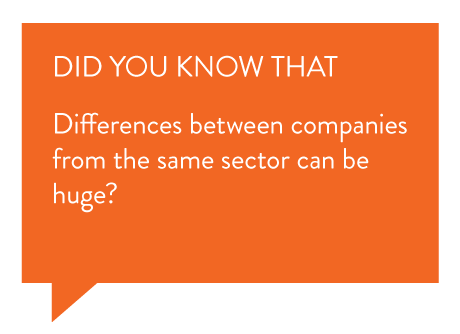
When matching employees to companies one should look at the attributes of both the company as well as those of the employee. Recruiters commonly solve this by scanning applicant’s CVs and performing job interviews with potential candidates. This, besides not being quantifiable, is a very time consuming process of which machine learning and statistical analysis can help to cut assessment times and increase process accuracy. At talent data labs we developed an automated matching algorithm that incorporates cultural and personality analysis, publicly available data and career history. That companies and industries differ culturally is common knowledge. Exactly how they differ, is unclear. For this reason we decided to research to what extent we can discriminate between corporate cultures across industries based on our algorithms. How good is our algorithm in detecting differences between cultures? In what way do industries differ? Are our findings expected? Let’s have a look!
One of the most important things we look at in our matching system is company culture. Company culture has been shown to have a tremendous effect on company functioning as well as employee well-being (Widodo & Silitonga, 2017, Gorden & DiTomaso, 1992). Cultural aspects can determine how flexible a company can be to an ever-changing market or how employees feel about their job, their team and the organization at large (Widodo & Silitonga, 2017).
“Company culture has been shown to have a tremendous effect on company functioning as well as employee well-being”
At Talent Data Labs we have developed a scientifically validated, efficient and effective way to determine in how far an employee fits in any given company. By looking at the preferred cultural environment of an employee and the established culture of an organization, we can generate a “fit score”. The higher the fit score, the better the employee-company match.

Apart from matching, company culture can be used to compare companies and even industries. In the first of a series of data analysis blogs we will take a look at what our culture assessment tool can tell us about culture across different industries.
Our cultural matching algorithm takes over 17 cultural aspects into account.To measure the strength of preference, subjects assigned points from a pool,the higher the importance of a cultural aspect, the more points were attributed to it. The cultural factors include things such as: the need for work-life balance, prestige, autonomy, a motivating environment and having a business focus. Every single person in our database partook in our cultural matching program and because of this we have collected a tonne of data from a wide range of companies and industries. (We are aware, of course, of the implications our data can have for individuals and companies. For this reason, we anonymize our data so that details such as company and person names remain hidden for third parties.)
When comparing industries, we ignore the differences between companies for a moment. We group all companies from a given industry together so we can say something about the field at large e.g. “Is the culture in the automotive industry different from the legal sector? How does it compare to banking?”.

What stood out from our analysis was that when you differentiate between industries, you find a lot of similarities. For instance, across all industries people find compensation, autonomy and work life balance important. Differences arose however, when looking at a subset of cultural attributes.
In order to find out whether there were cultural differences between industries we used the nonparametric Kruskall-Wallis test. We compared 12 industries (with a minimum sample size of 40 employees). We found significant results in 6 cultural domains, namely: prestige, motivating, expertise, socially active and rapid change. The post-hoc analysis (to see what industries differ from the rest) was done using the Mann-Whitney U test and is summarized in figures 1 through 4.
Prestige: the drive to become the best in class (H(11) = 19.69 , p <0.05)
Motivating: the longing to work in an environment that stimulates and motivates the worker (H(11) = 19.94 , p < 0.05)
Expertise: the demand of working in an environment with people who have expert knowledge on important topics (H(11) = 58.91 , p < 0.0001)
Socially Active: the willingness to socialize with colleagues (H(11) = 27.09 , p < 0.001)
Rapid Change: the willingness to adapt to a market and change strategies when needed (H(11) = 38.30 , p < 0.001)
Teamwork; the willingness and need to work in a team (H(11) = 27.74 , p < 0.01)

Figure 1. Prestige: Employees in the energy sector attribute significantly less cultural weight to the Prestige. In the Legal sector we see an opposite trend.

Figure 2. Expertise: Employees in the legal sector favor the presence of Expertise, as can be seen by its significantly higher cultural weight in comparison to other sectors.
“Employees in the legal industry have a higher drive for prestige and expertise”
Though cultural differences are more likely to appear between companies than industries (I am planning to write about this eventually, please show your interested in that by liking or commenting on this post), the legal sector seems to have a

substantially different culture from the rest of industries in our database. Employees in the legal industry have a higher drive for prestige (figure 1) and expertise (figure 2). Legal’s drive for a prestige driven environment goes very well with another finding; people that work in the legal sector don’t feel a strong need for a motivating environment (figure 3).

Figure 3. Motivating: Employees in the automotive industry require a motivating environment significantly more than employees from other industry types. The legal sector however, shows the opposite trend.
Getting into the legal sector is not an easy task, it requires one to gain academic excellence and prestige by “passing the bar” which likely requires the ability to self-motivate. Adapting rapidly to change, is likely not as important because detrimental changes in jurisdiction do not appear often. This is also reflected in their relationship to rapid change (figure 4) which employees find significantly less important than those from other industries do.

Figure 4. Rapid Change: The legal sector puts less value on rapid change than other industries. In consultancy, however, adapting to rapid change seems significantly more important.
“Many cultural differences can be found. This leads to different recruitment strategies”
Apart from the legal sector, some other sectors showed significant deviations from the mean. For instance, the Energy sector scored significantly lower on Prestige than the other industries. Whereas the automotive industry scored significantly higher on motivating environment and low on rapid change.

In short, it becomes evident that, even though there are many similarities between industries, many cultural differences can be found. Recruitment strategies, however, rarely quantify the company culture and that of the employee in a systematic and scientifically valid way. With our cultural analysis we show that company culture is measurable and quantifiable.
As companies within the same industry are more likely to have different company cultures than industries on an industrial level, it becomes increasingly important to differentiate between companies and perform company-employee matching. In our next blog we will show our matching algorithm, which can characterize people’s preferable corporate culture and map in how far they fit to a given company. In addition we will show the consequences of a company’s cultural style on organizational commitment, engagement, job satisfaction, team satisfaction and boss satisfaction. Finally, we will provide some tips on how the recruitment cycles could benefit from our matching algorithm. Stay tuned!